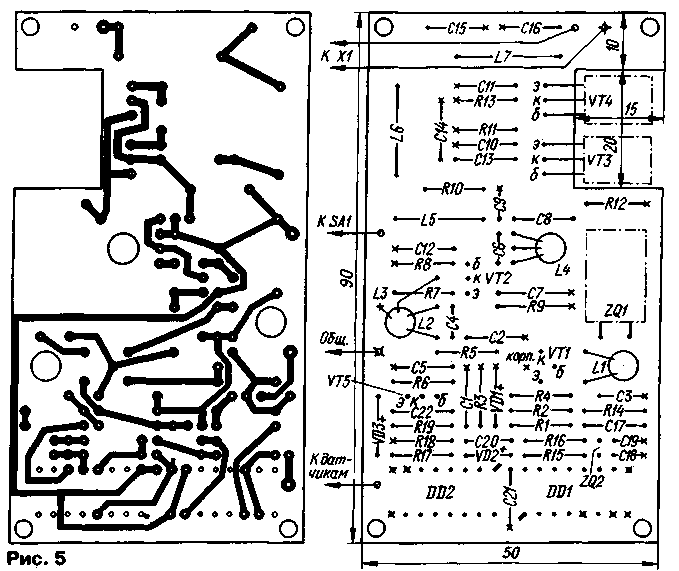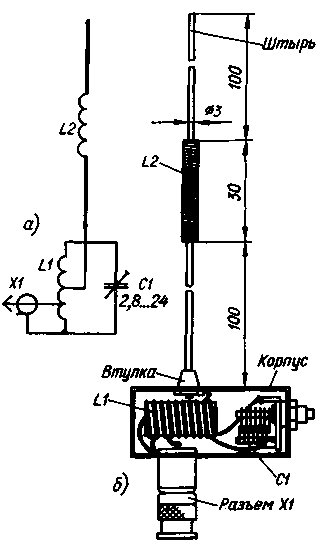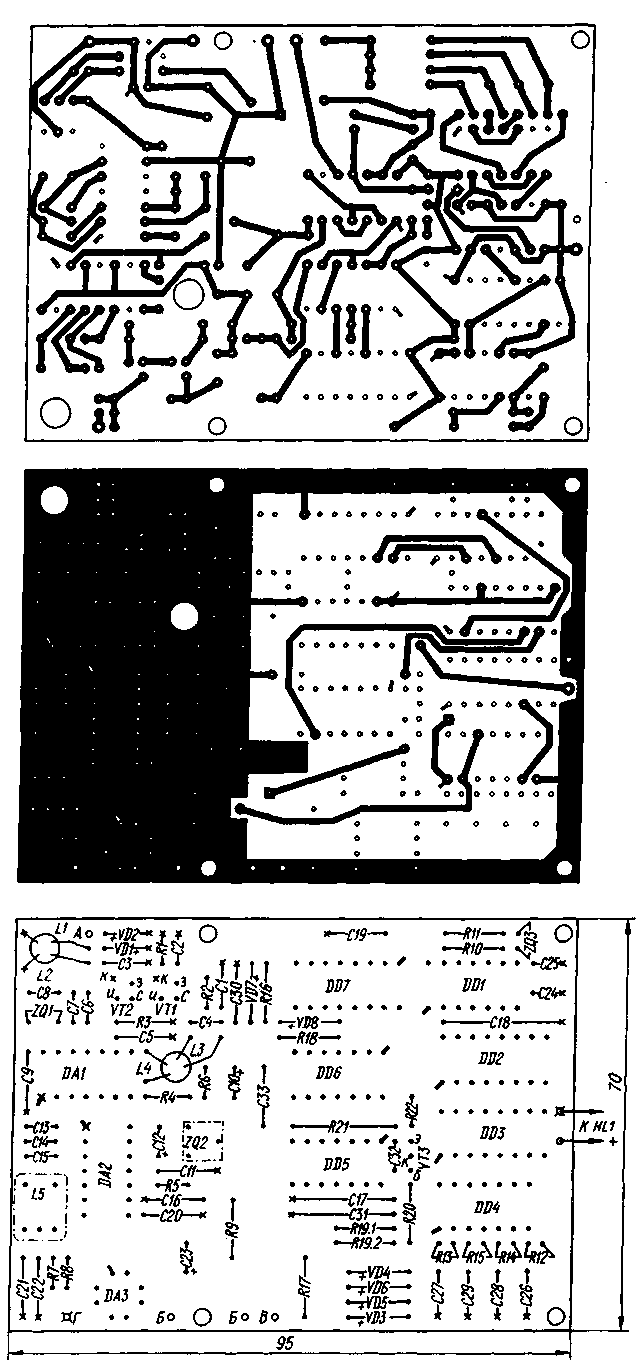The transmitter is assembled on a printed circuit Board from bilateral foiled fiberglass 1.5 mm thick. a Drawing card is presented in Fig. 5. On the component side foil preserved and serves as a common wire. The findings are soldered to GND without holes. For the remaining conclusions are drilled through holes and the common wire razzenkovannoe. All soldering points to a common wire is marked in the drawing crosses. The holes for the "grounding" the leads of the chips do not need to countersink.

Fig.5
At the points of connection of the Board with an antenna connector X1, the power source and the sensors are pressed into the holes and opaânnymi tin pins with a diameter of 1 mm as pins convenient to use the contacts from the connector RM.
Transistors VT3 and VT4 are soldered to the printed conductors, conclusions must bend at a right angle. During final Assembly of the transmitter transistors screwed to the metal casing of the device, serving to them in the sink. Exclude them from the casing of thin mica spacers.
The transmitter used resistors MT and MLT, capacitors km-5 km-6. Transistor CTV can be replaced by any low-power silicon structure n-p-n transistor and CTA - any of the series CT, CT. Instead CTA suitable transistors series CT and CT, but will have to overcome the difficulties of heat sinking.
Diodes VD2 and VD3 - any silicon thin. The varicap LW 110A to replace SW109, SW124, D with any letter index. Quartz resonator ZQ1 - standard, flattened metal casing, a ZQ2 - in miniature cylindrical casing of watches.
Coil L1 L2L3 L4 and is wound round three polystyrene frame with a diameter of 5 mm, equipped with trimmers carbonyl iron. Coil L1 consists of 25 turns of wire sew-2 0,25, coils L2, L4 -12 turns, a L3 - 3 turns of the same wire. The coil L3 is wound on top L2, and L4 is a branch from the third from the top of the loop scheme.
The inductor L5 is wound on the ring size K10h6h3 ferrite NN. The winding has 15 turns of wire sew-2 0,15. Coils L6 and L7 - frameless, is wound round the mandrel with a diameter of 8 mm and contain 5 and 9 turns of wire sew-2 0,8 respectively.
The transmitter is mounted in a metal box the size of HH mm On the walls of the housing has a power switch (SA1), high-frequency connector SR-50-FV (X1) and the four-pin connector RM (Fig. 1, not shown) for connecting the power source and the sensors.
The electrical circuit of a compact helical antenna whip normal radiation [3], designed to work together with the transmitter shown in Fig. 6,and its design - in Fig. 6,b. On the body pads cable connector SR-50-FV strengthen small plastic box (its size is not critical), which establishes the LC-circuit consisting of a coil L1 and a trimmer capacitor C1 with an air dielectric.

Fig.6
Coil L1 is wound with a pitch of 2 mm silver plated copper wire with a diameter of 1 mm on a ceramic frame with a diameter of 10 mm, Number of turns - 15. Places of taps is determined by adjustment of the system. The capacitor C1 is KVM.
An extension coil L2 is wound a coil to a coil on the frame 6 mm in diameter made of organic glass. It contains 130 turns of wire sew-2 0,15. At the ends of the frame are fixed on thread two brass pins. The lower end of the lower drawing-pin screwed into the hole of the brass bushing mounted on the upper wall of the plastic box.
The receiver is assembled on a printed circuit Board from bilateral foiled fiberglass 1.5 mm thick. a Drawing Board shown in Fig. 7. Just as on the Board of the transmitter, under the elements of the high-frequency receiver foil saved and plays the role of a common wire. Saved and plastic frame around the digital hub. To connect the Board with the antenna, the sound projector BF1 connector and the power source in the same way as in the transmitter is pressed and opaânnymi contact pins with a diameter of 1 mm.

Fig.7
You should pay attention that the number of mounting points of the Board relating to digital node, you must solder on both sides. At two points - they have the drawing is not round, but square - must be pre-inserted in the holes with a short wire jumper.
In the receiver are used resistors MT and MLT; oxide capacitors - K53-19, and the rest - km-5 km-6. You can use parts of other types. Transistors KB can be replaced by a single dual gate, for example, CPB. Diodes VD1 and VD2 - any silicon high frequency or pulse, and the rest - low-power silicon. Instead PPP-060.1 other suitable piezophilic at this frequency, with a bandwidth of at least 3 kHz, for example, PPP-60, PPP-61. Quartz resonator ZQ3 - miniature, in the cylindrical housing.
Coils L2 and L1 L3L4 wound on two identical polystyrene frame with a diameter of 5 mm, equipped with trimmers carbonyl iron. Coils L2 and L3 contain 18 turns of wire sew-2 0,33, the winding turn to turn. Coil connection L1 and L4 - 3 coils of wire PAVLO 0,2 - wound on top of its contour from the grounded output coil L2 and the output coil L3 connected to the positive power wire. Coil L5 used industrial manufacturing inductance 120 µh with podstroechnik. Independently it can be wound into an armored magnetic core SB-9a, the number of turns - 80, wire - sew-2 0.1.
Card installed in a plastic case from a pocket receiver dimensions HH mm Antenna - telescopic length of about 50 cm To power the receiver used a remote network unit with an output voltage of 12V, supplemented by the voltage regulator on a chip CREE and weekends oxide capacitor 10 µf for a voltage not less than 16 V. To reduce multiplicative noise both outputs of the secondary winding of the mains transformer unit is connected to its output minus the wire through the ceramic capacitors of 0.1 μf. For the battery of the receiver can be applied 7D battery-0,115-1.1.
To build and develop the system in a certain order. First, in the transmitter and in the receiver gather the digital part, but without a resistor R17 to the receiver and the transmitter are installed resistors R4, R5 and R7. Connect the supply circuit of the transmitter and receiver, the collector of transistor VT5 transmitter connected to the inputs of the element DD5.1 receiver.
When the power supply may be included or may not be included audio signal, however, with the arrival of the first pulse transmitter should briefly flashing led HL1 and start singing (or continue to sound) signal. Through 16 with HL1 led should flash again, and the signal - to stop. Further, the led will turn on for 1 sec every 16 and the audio signal is to be switched off. I
Then, in the pause between the pulses should be short circuit the capacitor C31 of the receiver that will simulate the transition of a transmitter in a continuous mode. Immediately shall sound the signal. To disconnect the capacitor C31 and make sure that after the passage of two pulses from the transmitter (this is well illustrated by the led flashes HL1) beep stops. To disable the inputs of the element DD5.1 receiver from the collector of the transistor VT5 transmitter - not later than 15 must sound the alarm.
Next, install the transmitter resistors R1-R3, R14, and in the receiver - R7-R9, R17, capacitors C21, C22 and comparator DA3. In a common point of the resistors R7 and R8 receiver via the button served from a common point of resistors R2 and R3 transmitter pulses with a frequency of 1024 Hz. When closing and opening of the contacts button should be switched on and off led HL1 with a slight delay (it should be visible to the eye).
If the nodes do not operate as described, the problem is, as usual, when establishing a digital device - check the operation of kartsovnik generators, the accuracy of frequency division in the counters and the formation of the corresponding signals, etc If the manipulation button of a pulse signal of a frequency of 1024 Hz, the led does not turn on, choose a resistor R19 and possibly R20. For fine selections of resistor R19 he divided into two parts (and on the Board for them provides space), which is correlated to resistance as 9:1.
After complete Assembly of the device configuration of the radio should start with the transmitter. Temporary jumper connect the emitter and collector of transistor VT5, and as an equivalent antenna transmitter output load resistor 51 Ohm power 2 watts. At the time of tuning transistors VT3 and VT4 must be installed on dural plate or copper heatsink with dimensions not less 100x60 mm.
Filing for transmitter power supply voltage and rotating podstroechnik coil L2, achieve generation. At the base of transistor VT2 must be present RF voltage of 0.6 V. It is measured broadband high frequency oscilloscope or voltmeter. The buffer stage transistor VT2 adjust the rotation of podstroechnik coil 1-AR4 maximum amplitude at the collector of transistor VT2 (at least 5 In). Thus on the basis of transistors VT3 and VT4 should be a voltage of less than 2 V. Dilating and constricting coils of the coils L6 and L7, achieve the maximum voltage on the dummy - 10...12 V. the Setting of the transmitter clarify in the same order after it is installed in the housing.
Then configure the transmitting antenna. In the middle of the metal plate (you can use coated fibreglass) dimensions not less than 250 × 250 mm establish a socket connector SR-50-TV and connect it with the output of the transmitter cable, to which the antenna will be connected to it by car. Install the antenna pin part of the connector in the socket and turn the transmitter for continuous operation. Control maximum dimensions are on the field strength indicator. You can use a simple wavemeter [5] by connecting the output of small microammeter.
Circuit L1C1 antenna tune in resonance to the maximum readings. Next, choose the location of the outlet from the coil to the side of the transmitter (2...3 turns) and in the direction of the pin (6...10 turns), also achieving the highest field strength. After installing the antenna in the car tuning circuit L1C1 specify.
For adjustment of the receiver, it is desirable to use a wideband oscilloscope. First if amplifier. A signal frequency of 465 kHz with 3 kHz deviation at the input of the circuit DA2 (pin. 13) and adjust the contour L5C14 rotation of podstroechnik coil L5дo the best Squareness and pulse ratio equal to two, the output circuits DA2. If it is determined self-excitation circuits DA2, the coil L5 should shall be shorted low power resistor 5...10 kOhm.
Then check the operation of the oscillator. If necessary, choose capacitors C6-C8 to obtain stable generation of the third mechanical harmonic quartz resonator ZQ1.
Next, check the voltage at the source of the transistor VT2, it must be in the range of 0.3...0.5 V. signaled with an operating frequency at the receiver input, the rotation of trimmers coils contours L2C3 and L3C4 set up the circuits in resonance, focusing on maximizing the sensitivity of the receiver (about 0.5 µv).
In the absence of a signal generator it is possible to replace the configured transmitter without the antenna and put it to the above-mentioned resistor 51 Ohm. Have a first transmitter next to the receiver, and as you configure your remote transmitter at the maximum distance, controlling the reception of the signal on the oscilloscope connected to the output circuits DA2, or by the LEDs HL1.
The transmitter is quite economical - a fully charged automotive battery with a capacity of 55 amp-hours is enough for three months of continuous work in standby mode.
The described radiozero has more than three years and has already helped to prevent intruders in the car.
A lot of useful information on building a radio patrol car and various structural embodiments of antennas of the transmitter and receiver are contained in the publications [1; 6-8].
Literature
5. Golubev, O. a Simple wavemeter. Radio, 1998, No. 10, p. 102.
6. Vinogradov, Y. Radio alarm. The receiving unit. Radio, 1995, No. 4, pp. 47-50.
7. Vinogradov, Y. Disk antenna in the range of 27 MHz. Radio, 1997, No. 2, p. 70.
8. Vinogradov, Yu CB antenna on the window. Radio,1998,№ 4,p. 80. Radio 5/2000, p. 44-46
Author: S. Biryukov, Moscow; Publication: N. Bolshakov, rf.atnn.ru






